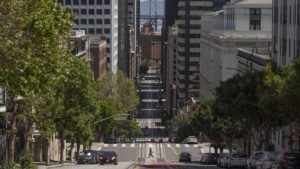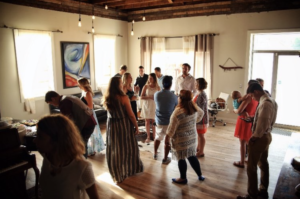A recent Harris Poll of 2,050 Americans found almost a third are reevaluating their lifestyles and considering a move to a less densely populated area as a consequence of the coronavirus outbreak.
 More than two-thirds (39%) of urban residents have said that COVID-19 has prompted them to consider leaving for a less-crowded locale, with 18- to 34-year-old Americans the most likely to consider moving. With many expected to continue remote work schedule post-pandemic, suburban and rural areas with their lower cost of living and improved quality of life are considering ways to compete for these Gen Y and Zers and the buying power they bring with them.
More than two-thirds (39%) of urban residents have said that COVID-19 has prompted them to consider leaving for a less-crowded locale, with 18- to 34-year-old Americans the most likely to consider moving. With many expected to continue remote work schedule post-pandemic, suburban and rural areas with their lower cost of living and improved quality of life are considering ways to compete for these Gen Y and Zers and the buying power they bring with them.
Starting out has been a struggle
As much as the media loves to celebrate the lifestyles and design trends of the young and urban, it turns out that this group is a little less keen on the city than one might first imagine. To begin with, this Boomerang Generation entered a pre-Covid job market marked by rising unemployment and record-high student loan debt. Couple this with lower starting salaries, and an ever-increasing costs of living, it’s no wonder we’ve seen many 21-35-year-olds struggle to lift off. 
Staying home helped with the down-payment, but…
If one was lucky enough to stay employed during 2020 WFH season, the lowered cost of living has helped many save enough for a down payment on a house, according to a recent Bank of America study. Soon after the pandemic began, historically low interests rates helped to ignite a housing boom. But increased demand intensified the effects of shrinking housing inventory. Black Knight found 40% fewer homes on the market than last year at this time. And Freddie Mac estimated the US was short 3.8 million homes. “There have been 20 times fewer homes built in the past decade than in any decade as far back as the 1960s,” said Daryl Fairweather, chief economist at Redfin. “There just aren’t enough homes for millennials to buy.”
So what’s a “second city” to do?
The move away from expensive hubs like New York City and San Francisco to more affordable ones like Nashville, Phoenix and Austin is on. But beyond housing stock, average home prices or state income taxes, there are many underlying factors that influence moving decisions. Critical qualities such as inclusivity, equity and sustainability are emerging as key moving considerations. But how can municipal authorities adapt public spaces to make them as accessible and equitable as possible?
American suburbs need inclusive spaces
“All forms of urban planning draw on a cluster of assumptions about the ‘typical’ urban citizen: a bread-winning husband and father, able-bodied, heterosexual, white, and cis-gender,” says Mount Allison University professor of geography and environment, Leslie Kern. In her book, Feminist City, Kern highlights that women and other marginalized groups are often excluded from planning decisions that directly affect them, creating numerous barriers and sources of friction for large segments of the population.
Many who’ve become used to the public transportation solutions common to large cities are noticing an immediate gap in suburban and rural areas. Luckily some progressive regions are thinking fast and adapting to these changing needs. Mobility company Via has partnered with the Delaware Transit Corporation to create a solution for the state’s rural residents through a microtransit program called Dart Connect, the state’s first on-demand microtransit service.
Created under the Federal Transit Administration’s Accelerating Innovative Mobility grant program, the service uses smaller vehicles to provide shared rides within 15 minutes of a ride request. “DART Connect increases service frequency and expands access to transit for thousands of residents, workers and visitors lacking access to a vehicle or who rely on bus service to travel to jobs, medical and social services throughout these communities.”
Small town revival
In the past, small towns suffered as young people moved up and out to bigger urban cities, stripping communities of badly needed tax revenue and threatening local school systems. But with next-gen desire for affordable housing and balanced lifestyles, the tables are turning – they’re finding their way back to small towns.
Power of attraction
As next-gen buyers look beyond cities to achieve their American dream, small towns wanting to win their favor and the subsequent economic rewards will need to be willing to meet the needs of these entrepreneurs, growing families and diversity-seekers. Affordable housing stock is a start, but just as important is listening to the changing needs of transitioning residents. “They want to take a walk with their kids to the local community garden. They don’t want to be expected to pull all-night shifts every week. They want the small-town rhythm and community” says community advisors, Pioneer Georgia
Community is key
Smaller cities, suburbs and towns that will thrive during this migration will be those that embrace change by listening to the requests of its new residents. Those that evolve to include the best of what a city has to offer – innovative transport solutions, walkable downtowns, with gyms, and cafes – and the easy accessibility to nature and social gatherings of a less populated municipality are ticking all of the boxes for a robust community. New and old, all citizens will reap the rewards of a place that grows to make newcomers feel welcome and, most importantly, at home.
Stephens Waring is an internationally recognized and award-winning marine architecture and engineering design studio located in Belfast, Maine. The team brings fresh and exciting concepts that meld beauty and practicality from inception through creation.
Call anytime. We are always interested in partnerships and opportunities. (207) 338-6636

